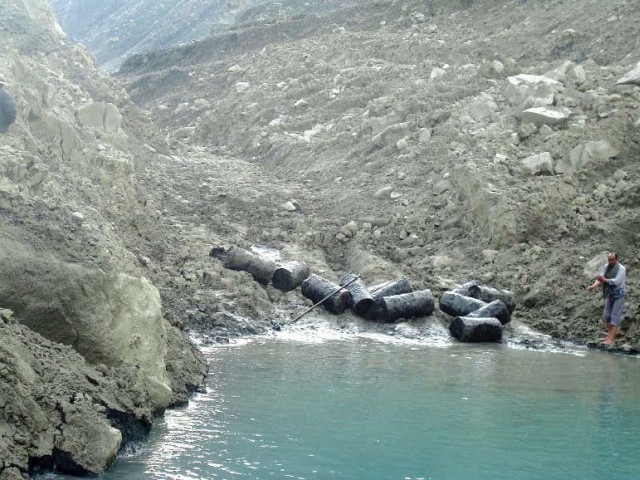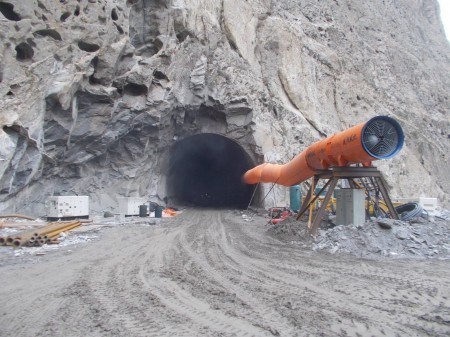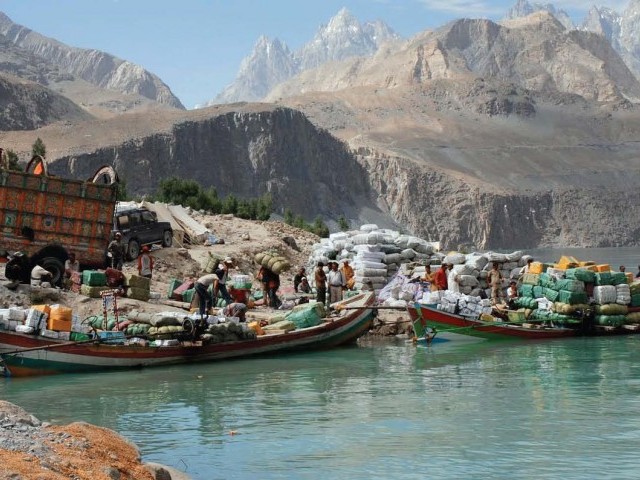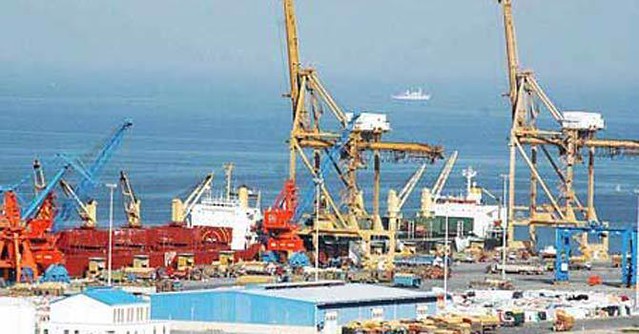By Tayyab Baloch, TwoCircles.net,
Gilgit-Baltistan/Islamabad: A 40-year old local trader Muhammad Ali Rocky was extremely tired but he still had to cover a long distance in a boat towards his hometown through artificially formed Attabad Lake carrying China-made electronic goods, some 144km from Gilgit, capital of Gilgit-Baltistan.
On his way back to his home land Gilgit, he purchases some accessories from China to sell them out in Pakistan on a higher price and makes some profit. He is afraid of rowing in Attabad Lake because the traders have been facing problems due to closure of trade posts in northern areas.
Ali Rocky is worried whether he would be lucky enough to cross the Attabad Lake safely or would have to face any loss. He was just recalling the past days when Silk Road, also named Karakoram Highway (KKH), was smooth before massive landslide in January 2010 blocked Hunza River that resulted in emergence of Attabad Lake.
After a safe journey on ferry service with smiling face and sparked eyes, he thanked to Almighty Allah! While shifting goods from boat to tractor trolley he said that the 20km long Silk Road (KKH), the sole overland connection between China and Pakistan, was submerged by Lake. It is due to that catastrophe, cross-border trade between the two countries has declined with the state of local business lying in ruins.

A view of the Attabad Lake spillway. PHOTO courtesy by: Express Tribune
According to a report issued by World Bank in 2013 some 60 percent of Pakistan’s population is living under the poverty line. It is due to limited job opportunities and low foreign investment along with poor law and order situation, the job opportunities in the country have been reduced to the considerable level.
Same is the case with China where despite the fact that the country has made enormous progress in the field of economy, still some 20 to 25 percent people are living under the poverty line. China is also facing the issue of unemployment like other countries of the region. About 40 per cent of China’s poor people live in its seven autonomous regions and provinces.
Muhammad Ali Rocky says, “The business community of the area is under heavy debt, the Sust Dry Port, which used to generate income from taxes, custom duties and other charges, is now on the verge of terminal decline and blockage of KKH has rendered hundreds of small traders and workers jobless.
According to Gilgit-Urumqi Business Forum President Nazir Ahmed the situation has turned from bad to worse so he has demanded of the government to introduce tax concessions for the business community of Gilgit-Baltistan because local traders got affected by the formation of Attabad Lake on KKH, blocking trade activity between Pakistan and China.
Gilgit based Ahmed said that the business community had suffered heavily due to the lake. “Since this trade route was only bread and butter for local businessmen, its blockage has left hundreds of small traders, peasants and workers jobless,”, he said, adding that the government has not taken measures to provide any kind of relief to the small traders and peasants.
A study on “A Socio-Political study of Gilgit-Baltistan” conducted by Omar Farooq Zain stated that Northern areas are strategically important in terms of geography as well as trade because of its borders with China, Afghanistan and India. As a potential gateway to Central Asia states, the strategic location of Northern Areas becomes unique.

The Karakoram Highway is being realigned in Hunza. The Economic Corridor will pass through the Gilgit-Baltistan region. PHOTO courtesy by: Mirbaz Khan
In addition to the trading importance of Gilgit-Baltistan and its environs, its location at the doorstep of China and Central Asia, with Afghanistan and India close by, makes it a very strategic area culturally and geopolitically.
K. Warikoo in his book titled “Himalyan Studies in India” pointed out that British used Ladakh and adjoining areas in Gilgit, Skardu, Hunza and Chitral as “frontier listening posts” to monitor the developments in Central Asia and Xinjiang throughout the Dogra period.
The leadership of both Pakistan and China in the recent past had thought it advisable to build up an economic corridor that can open up the underdeveloped areas of the region to a new era of economic development and prosperity.
The high ups of both countries have termed Pakistan-China Economic Corridor as ‘future of the world’, as almost three billion people, which is almost half of the world’s population, from China, South Asia, Central Asia could benefit from this economic corridor.
The official data provided by Pakistan’s Federal Ministry of Planning and Development showed that being one of the biggest transit trade routes in the world, it would link China to the Middle East, Central Asia, Africa and other regions and provide access to the landlocked countries to the world biggest markets, India and China.
It stated that the Pakistan-China Economic Corridor would be of high economic value as about the 3 billion people at both sides of the border would be its direct beneficiary while the overall bilateral trade volume would be increased to 7 billion dollars.
The data further showed that Pakistan intends to get the maximum benefit out of this project and for that it has planned to establish industrial parks and economic zones along the Kashgar-Gwadar trade corridor.

Local traders using boats to carry goods at Attabad Lake. PHOTO courtesy by: Express Tribune
These economic zones would provide employment in the areas where these zones would be established. The overall size of an economic zone within a certain area will depend upon the availability of the raw materials, agricultural production, and the economic strength of the area.
Gilgit, Abbotabad, Kohlu, DG Khan, Bhakkar, Rajanpur, Kashmore, Jaccobabad, Khuzdar, Basima, Punjgur, Turbat and Gwadar are the proposed sites for the establishment of industrial parks.
The Pakistan’s central government’s seriousness to get maximum benefits from the Pakistan-China Economic Corridor can be judged with the fact that it has already approved the projects worth 52 billion dollar to be started in the economic zones.
A prominent economist Dr Zafar Mehmod opined that the poverty rate would be reduced to the minimum while the unemployment would almost come to an end. He said that Pakistan, through utilizing the potential of Silk Trade Route can be one of the biggest transit trade routes that would generate considerable economic benefits for the country.
Talking about the economic corridor, the high official of Ministry of Kashmir Affairs and Gilgit-Baltistan Javed Shahzad Malik said the dream of building up economic corridor is being translated into reality and work is under way to upgrade KKH, motorways, and railway lines, fiber optic, and oil and gas pipe lines.
He said a number of tunnels with overall length of 200 km would be constructed on different locations to maintain the vehicular speed on KKH at 80 km per hour.
Malik said the federal government has planned to deploy highly skilled 1,500 security personnel with automatic weapons for patrolling on KKH.
Hafizur Rehman, a local notable and leader of a Pakistan’s ruling party Pakistan Muslim League PML (N), said that trade between Pakistan and China had been carried out with barter system till1976.
He said after the construction of KKH and implementation of protocol act 1974 traditional (barter) trade system was replaced by current trade way. Until 2001 local trade volume was also high due to open trade.
According to data compiled by Pakistan Railways, a railway line along the KKH, connecting Pakistan and China is being constructed as an integral part of the Pakistan-China Economic Corridor.
The purpose of building a rail line is not only for trade purposes but also to transport energy, in case a pipe line is not a variable option. This rail track will be linked to Gwadar, where oil-refining and storage facilities are being constructed.
Dilating further about ambitious plan for economic development of the region Dr. Zafar Mehmood said after the revival of New Silk Route, Pakistan has realized its geographical importance and handed over its newly built Gwadar Port to China for connecting to Persian Gulf through Indian Ocean to South East Asia and Fareast.
“It is close to Strait of Hormuz, through which more than 13 million barrel oil per day passes and Tehran was also interested in laying an oil pipe line from its territory to Gwadar to transport crude oil for processing. Keeping in view the importance of international trade Pakistan has already declared Gwadar a free economic zone and China is also taking interest to build Gwadar Airport,” he said.

China controls Gwadar port in Balochistan province of Pakistan. PHOTO courtesy by: Business Recorder
In an interaction with Kabul based Journalist, writer and political activist who worked as Advisor in the Karzai government, Mr. Azam Beg Tajik stated that keeping in view of modern silk route and upcoming socio-economic changing scenarios, one can imagine the importance of Northern Areas. Hopefully, it will become a profitable hub and economic activity center, serving as a lifeline to the economy of the country in the years to come.
He said that besides Khunjarab Pass via China and then to Central Asian countries there are two others shortest potential routes via Chipurson Valley adjacent to Sost village, Irshad pass to Afghanistan and Tajikistan at a distance of only 80 miles from KKH.
Given the future economic prospects highlighted by the experts, government officials and local people it is expected the Pakistan-China Economic Corridor would not only help boost economic activities but also bring the socio-economic conditions and life standard of the people living in this region at par with other developed regions of the world.
(Tayyab Baloch is an Islamabad based journalist. He tweets at @blochjournalist )

